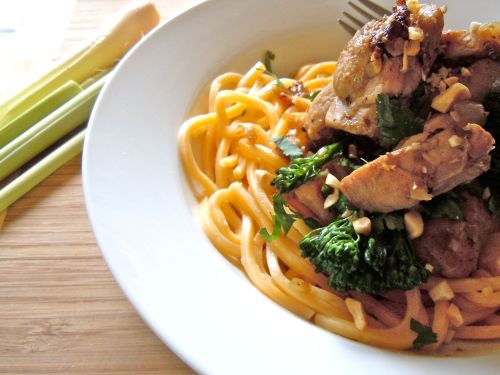I like this recipe from Simon Bryant as it includes three types of fresh herbs with the spices. The falafels, tucked into pita bread with peppery rocket, fresh tomato and yoghurt sauce are delicious. Leftovers of this classic street food provide a great lunch during the week.

Ingredients
1 400g can chickpeas
1 onion, chopped
2 green chillies, deseeded and chopped
2 cloves of garlic, chopped
5 tablespoons of parsley, chopped
3 tablespoons coriander, chopped
3 tablespoons mint, chopped
1 teaspoon ground coriander
1 teaspoon ground cumin
2 tablespoons plain flour
salt and pepper
½ teaspoon baking powder
sesame seeds to coat (optional)
vegetable/olive oil for frying
Yoghurt Sauce
2 cups natural yoghurt
1 clove garlic, finely diced
salt
To serve
1 lemon, chopped into wedges
2 tomatoes, sliced
rocket/baby spinach leaves/lettuce
extra herbs, chopped
pita bread
Method
There are a couple of ways to approach this recipe – with a food processor/blender – and by hand.
Food processor: Blitz chopped onion, garlic, chillies, cumin and ground coriander. Process until the mix is combined and the onion and garlic is finely chopped. Add chickpeas and mix until they are mashed up but still slightly chunky. Throw in the herbs as well as the salt and pepper. Add flour and baking powder and blitz to combine.
By hand: Mash up chickpeas with a fork or potato masher. Add finely diced onion, garlic and chillies. Mix in cumin, ground coriander, salt and pepper. Add finely chopped herbs then the flour and baking powder. Stir well to combine.
Taste the mix and check the seasoning. Transfer to the fridge.
Meanwhile make the yoghurt sauce by combining fine diced garlic with yoghurt, add a sprinkle of salt. Prepare accompaniments (slice tomato, halve pita breads, wash greens, cut lemon into wedges). Pre-heat oven to 180C.
Roll mix into about 16 rounds, about the size of a golfball. Flatten slightly. Roll in sesame seeds if you wish.*
Heat oil in a non-stick pan. Brown in batches. The oil needs to be quite hot otherwise the falafels may not keep their shape. Keep an eye on each batch – they cook quickly in the oil. Once both sides are browned, gently remove and place on a baking tray (lined with baking paper).
* If coating in sesame seeds – you may need to change the oil after each batch if the sesame seeds that have fallen off the falafel start to burn. I rolled my last batch in sesame for variety.
Bake in the oven for about 10 minutes to cook through.
Serve falafels with pita pockets, extra herbs, greens, tomato, lemon wedges and zingy yoghurt sauce.
Makes 16 falafels.
Adapted from Simon Bryant’s falafel recipe featured on The Cook and the Chef , August 2009.











